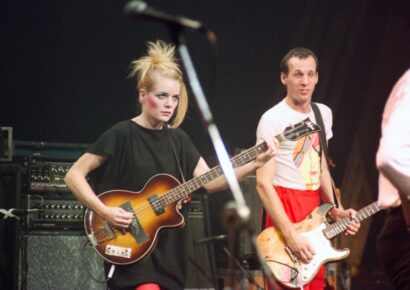The guitars in “Comfortably Numb” really are one for the history books!
“Comfortably Numb” is one of Pink Floyd’s most famous songs. The arrangement, composition, sound and legacy are the by-product of a feuding band, David Gilmour and Roger Waters’ disagreements over the song ultimately leading to its uniqueness. The Pink Floyd guitar tone, thanks to Gilmour’s guitar playing across the two solos in the track is iconic, becoming the essential Gilmour, Pink Floyd guitar tone to fans.
Read up on all the latest features and columns here.
Fighting within the band led to the blend of orchestral, ethereal parts with the heavy rock energy of the final guitar solo. Waters wanted a spacious, dream-like feel, reminiscent of the feeling of the muscle relaxant that ultimately inspired the song’s lyrics. Gilmour wanted a heavier rock vibe, resulting in the song traversing through genre as well as keys!
“Comfortably Numb” Acoustic Guitars
The song begins with something akin to an operatic, ethereal feel, with spacious, modulating arpeggiators providing a steady pulse. Acoustic guitars tuned similarly to Nashville tunings give the impression of a 12-string, the octaves rubbing and modulating against each other.
Nashville tuning is still E, A, D, G, B and e, but replaces the bottom (lower) three strings with the smaller gauge strings usually used for the higher octave of a 12-string set. In Nashville tuning, the bottom three strings are one octave up from their usual frequency.
In “Comfortably Numb”, the acoustic guitar sound throughout the beginning of the song is David Gilmour and session player Lee Ritenour playing acoustic guitars tuned to Nashville tuning, but with the low E-string replaced with a high e-string (i.e. two octaves above a regular E and one octave above the regular Nashville tuning). The two guitars have a sparkly, mandolin-esque tone, providing rhythm with the strum of the strings, without offering too much body or note that gets in the way of the synths and vocal.
Guitar Solo #1
In live versions of the song, Gilmour uses his classic Black Strat with a maple fretboard, and used a Strat into a HiWatt for recording the solos on “Comfortably Numb” as well as others on The Wall.
Fender Strat
Gilmour’s Strat featured some mods, including a toggle to engage the bridge and neck pickups at the same time for his signature Pink Floyd guitar tone. This gives the roundness of the neck position with the attack of the bridge but a uniquely, barking blues tone. Gilmour also pushed his amps to the edge of feedback for his signature, sustained tone.
Hiwatt amps
Hiwatt amps are known colloquially as a particularly “British” sounding amp, both borrowing from and influencing designs from Marshall and Vox. Hiwatt amps are more mid-focused than Marshall amps, and not as bright. Hiwatt are loud, clear and weighty sounding amps, tuned for rock and have been adopted by metal, noise, punk and post-metal band because of their volume, impact and presence.
Half-cocked wah
The tone of the solo is reminiscent of a wah trick used to help solos poke through: the half-cocked wah.
Using a (non auto-return) wah-pedal, engage the wah and set the pedal somewhere in the middle of its tread, and don’t touch it once it’s set! This creates a unique Q-shape to the frequency response (the wah pedal effectively being a foot-controlled EQ pedal). There’s also standard ‘half-cocked’ pedals available!
This allows you to find a good place that your guitar tone pokes through an arrangement, harnessing the ‘quack’ and nasal feel of a wah tone, without the need to rock back and forth for that classic, talkin’ guitar sound.
This tone is particularly present in the main riff to Dire Straits’ song “Money For Nothing”.
Yamaha RA-200 rotating speakers
The magic of Gilmour’s tone comes from something a little less well-known, the Yamaha RA-200. Similar to a Leslie cabinet or rotary speaker, the RA-200 had three spinning speaker within its cabinet, the sounds summing and cancelling for a phasey, modulating sound. A similar tone can be achieved with a rotary or Leslie effect pedal if you can’t find an original RA-200!
Big Muff
The drive and grit on these solos is thanks to an Electro Harmonix Big Muff. The Big Muff is a distortion/fuzz that offers a variety of tones from all out grit to the more subtle warmth and attack found on the “Comfortably Numb” solos.
Gilmour also uses string rakes to create suspense and he goes for increasingly high notes over the course of the first solo. String rakes are simple enough, but add dynamic, drama and texture to his solos!
Guitar Solo #2
While the foundation of the solo tone is similar to the first guitar solo, the second solo has one major notable difference: it’s stereo.
Stereo Haas effect
The clarity and hi-fidelity sound of the second guitar solo makes it sound like it’s been artificially made stereo, i.e. it wasn’t double tracked. There’s a variety of ways this could be done, either by double micing a single speaker cabinet, re-amping the room with a stereo mic setup, or by using short delays on a mono source.
Known as the Haas effect, or Precedence effect, is the effect of short echoes that mimic the first reflections of a room or space. This can make a mono source stereo, often with an exaggerated, wide effect, or give the impression of a mono source existing within a physical space when the Haas effect is blended in parallel with the main source.
The Haas effect can be used to help achieve the stereo sound of Gilmour’s second guitar solo, and requires a short, stereo delay (10-20ms of delay time, one on side) to achieve. Set the mix of one side of your stereo delay to 100% wet, and the other to 0%. This will make one side the original source, and the second a delayed version. The delay isn’t enough for the source to feel out of time, but it becomes enough for our brains to interpret the different sounds, so it becomes stereo. Shorter than 10ms and our brains will begin to struggled to differentiate the delay, more than 50ms starts become an audible delay.
This is a popular trick when mixing, you can create a seemingly physical space around a source by blending in an effected version of the source (again, panned left and right) with the mono source. In this case, set both sides of the delays to 100% and set different delay times, i.e. 25ms and 50ms. Blend to taste!
A subtle pitch shift of 5-10 cents (again, with different settings on each side) can help exaggerate the effect further, creating more width and difference between the two sides.
“Comfortably Numb” solo techniques
Finally, the second solo harnesses some great playing techniques to really accentuate the heavy rock influence of the end of the song.
There’s some funk and blues influence, the use of double stops and funk chords helping the solo to poke out through a dense mix. The percussive technique of the funky chords helps create more of a dynamic between the solo and silence, adding the heaviness of the section as a whole. Gilmour also used scratch notes, similar to the rakes from earlier, to add a percussion element to the whole section.
This makes his more traditional solo measures and runs more exciting as they’re book ended by percussive and chordal playing. The Pink Floyd guitar tones in “Comfortably Numb” really are some for the history books!







